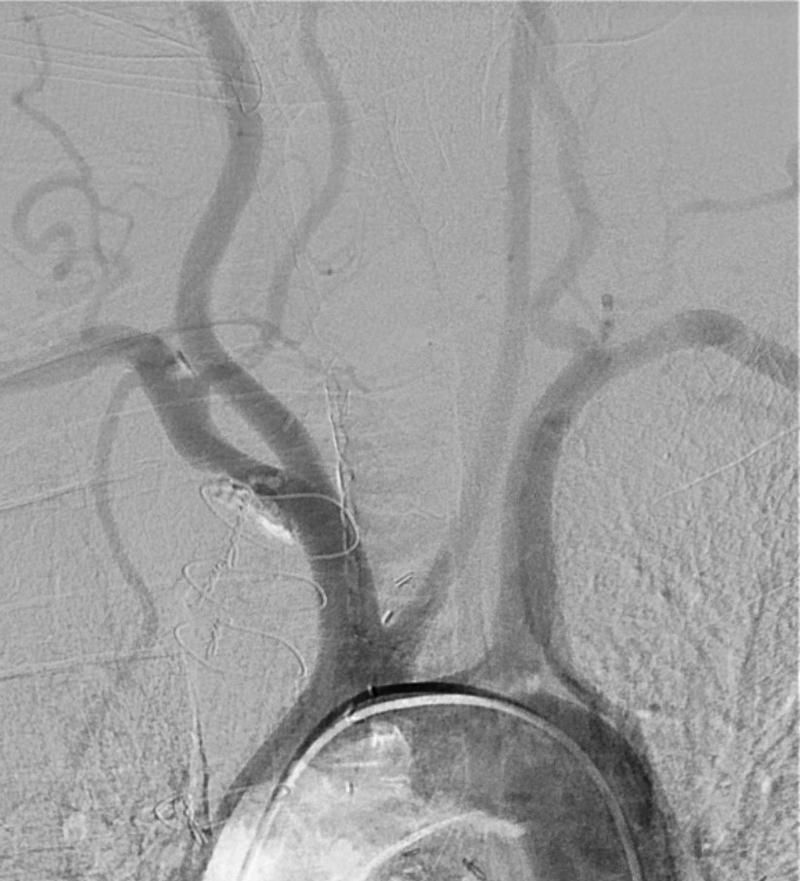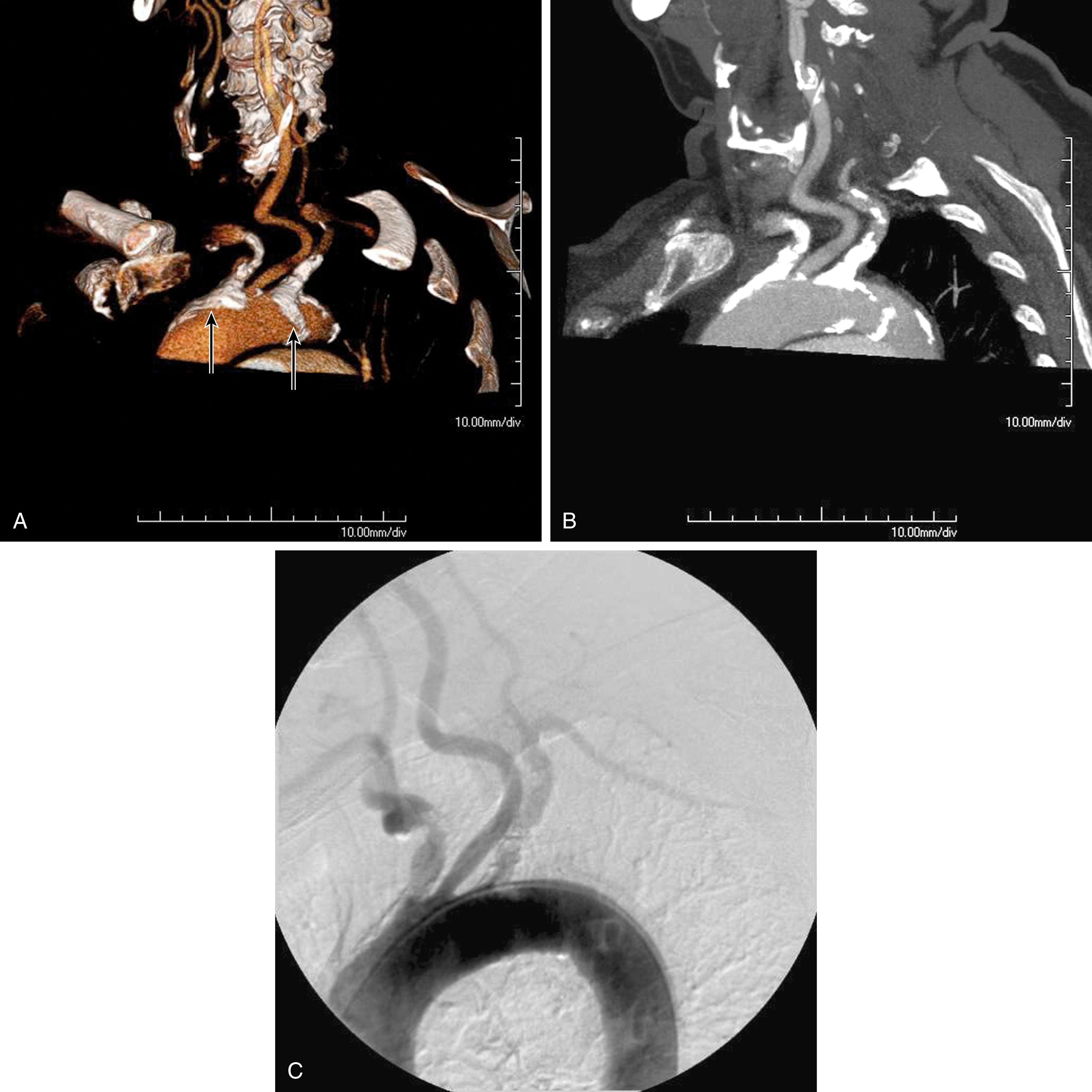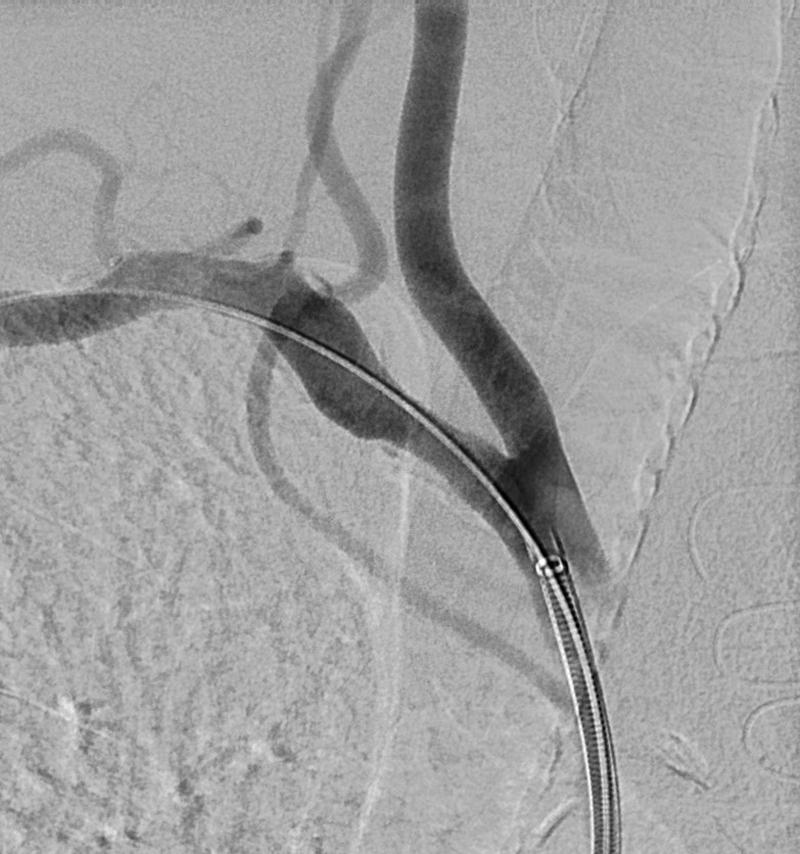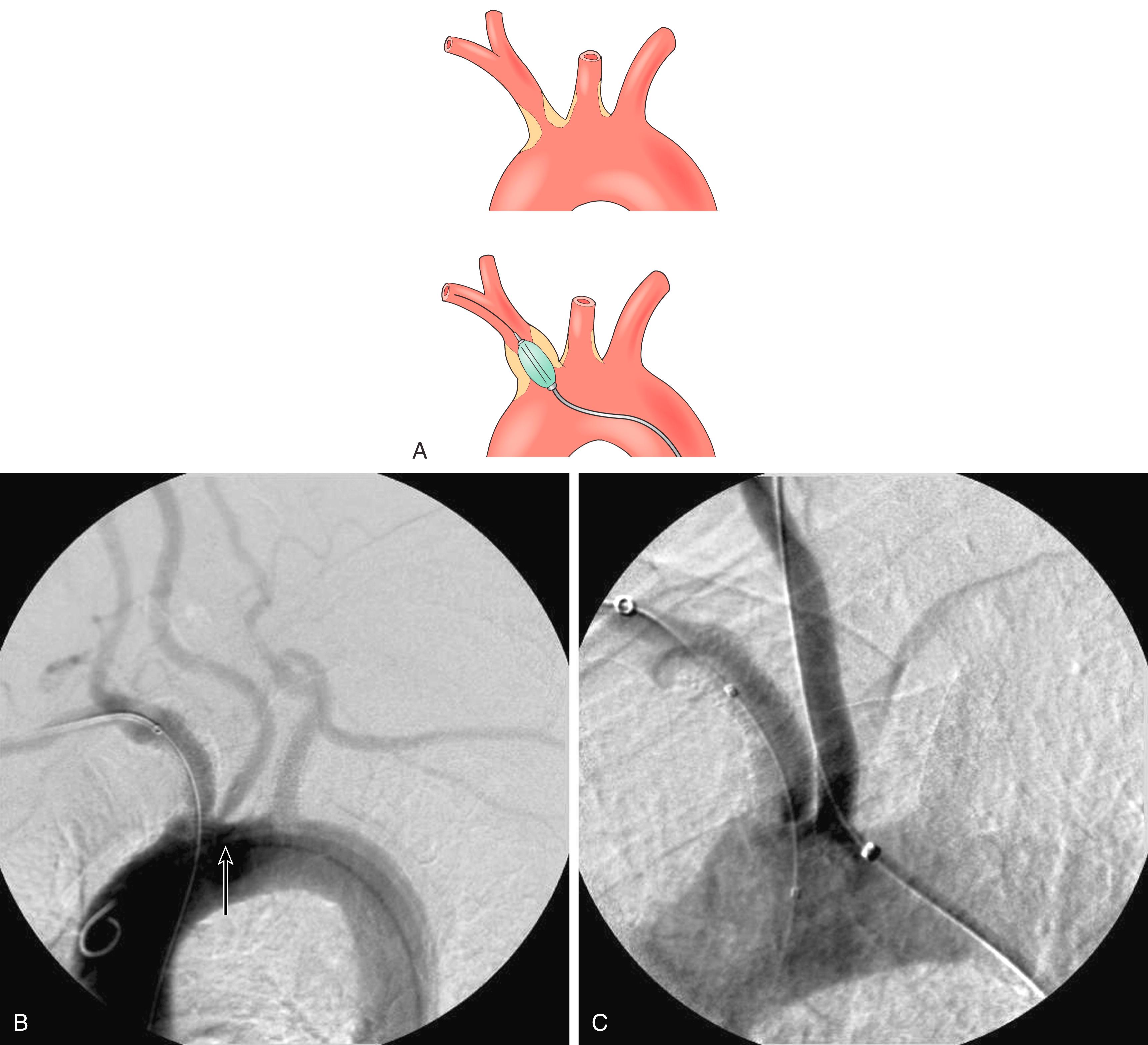Physical Address
304 North Cardinal St.
Dorchester Center, MA 02124
Brachiocephalic arterial disease presents a complex surgical challenge due to the frequent involvement of other arch vessels, choice of inflow and access, as well as the inherent risks of complex surgery, embolization, and cerebral ischemia. This process may affect the aortic arch and/or its branches, including the innominate, the proximal right subclavian (RSCA) and right common carotid (RCCA), the left common carotid (LCCA) and the left subclavian (LSCA) arteries. Early management of brachiocephalic arterial disease involved open surgery (see Ch. 101 , Brachiocephalic Artery Disease: Surgical Treatment) via a transthoracic approach , with high morbidity and mortality rates. The extra-anatomic approach offered a variety of options for poor sternotomy candidates or those with severely calcified aortas, but often with a reduction in long-term patency rates. , , As endovascular techniques have evolved, management has included a wider variety of options with acceptable results, decreased risks, and faster recovery times.
A great deal of the information on patients with occlusive disease of the arch vessels comes from reports of open surgical series. A detailed understanding of the anatomy of the aortic arch is a necessity for planning. The most common cause of arch vessel disease is atherosclerosis. In evaluations for carotid bifurcation occlusive disease, 5% to 15% of patients are found to have concomitant arch vessel disease. The prevalence of arch disease in patients without bifurcation disease is approximately 1.5% to 2.0%. In patients with coronary artery disease, the prevalence is 4% to 7%, and greater than 11% in those with significant coronary disease. The LSCA is involved most often, followed by the innominate and LCCA, which are both affected approximately 30% of the time. , Less common causes of arch vessel disease include Takayasu arteritis, radiation-induced injury, aneurysm, and dissection.
Ultrasound imaging of the supra-aortic vessels is often the initial imaging modality. Velocity information can provide insight into the degree of stenosis, and often the visualization of calcification can provide information regarding the nature of the occlusive process. However, the anatomic discrimination necessary to guide intervention can be obtained only with more detailed imaging. Lesions of the brachiocephalic arteries are often located proximal to the reach of ultrasound in the mediastinum or behind the clavicle. As a result, significant lesions may manifest by very low velocities in the CCA since they are measured distal to these lesions (see Ch. 22 , Vascular Laboratory: Arterial Duplex Scanning).
The most frequently employed methods for assessing the anatomy of the aortic arch are computed tomographic angiography (CTA) and magnetic resonance angiography (MRA) (see Ch. 29 , Computed Tomography and Ch. 30 , Magnetic Resonance Imaging and Arteriography). Axial imaging has the advantage of avoiding catheter manipulation within the aortic arch and its potential complications. CTA and MRA can be used to evaluate both aneurysmal and occlusive disease, assess the degree of stenosis or occlusion, lesion morphology, vessel configuration and other factors that are very helpful for planning revascularization. MRA is not as helpful in assessing the degree of calcification. Both CTA and MRA can define the intracranial circulation. The source images can be reformatted into three-dimensional models of the aortic arch and its branches to allow excellent visualization of the relevant anatomy with precise measurements. The presence and pattern of arch variants or anomalies will alter the complexity and influence the surgical or interventional approach. The usual anatomic makeup of the aortic arch involves three arch vessels: the innominate or brachiocephalic artery gives rise to the RSCA and RCCA; the left CCA; and the left SCA. In up to 20% of individuals, the LCCA originates from the innominate artery in a “bovine” configuration, or as a common trunk, thus leaving only two main brachiocephalic branches from the aortic arch ( Fig. 102.1 ). In as many as 6% of individuals, the left vertebral artery originates from the aortic arch directly, between the LCCA and LSCA. Finally, aberrant origin of the subclavian arteries (<1%), with or without an associated Kommerell diverticulum and/or a right-sided aortic arch, are best displayed on preprocedural axial imaging studies. There is also variability in the aortic arch as to whether the great vessels arise from the ascending aorta or the “top” of the arch. Aortic arch classification type significantly alters case planning and assessment of complexity. Elderly patients, especially those with years of hypertension, tend to have elongated or tortuous arches from which the branches are more likely to arise from the ascending arch, thus making cannulation and device passage from a femoral approach more tortuous and challenging. Given the wealth of information that affects procedural planning, every patient should have contrast enhanced axial imaging study preoperatively. CTA offers the added value of a clear understanding of surrounding structures and better discrimination and visualization of calcification ( Fig. 102.2 ).


Procedural planning and determination of the degree of stenosis can be achieved with axial imaging alone in most patients and angiography is typically performed as part of the therapeutic intervention to treat identified disease. In performing catheter-directed imaging, care must be utilized, as disease of the arch vessels is often associated with or directly caused by “spillover” disease of the aortic arch itself, in which aortic arch disease has extended into its branches. Catheter manipulation may potentially dislodge plaque and cause emboli. Flush aortography is performed with a pigtail catheter. As the arch progresses to the patient’s left, it also moves from anterior to posterior within the mediastinum. Arch imaging is best performed in a left anterior oblique (LAO) projection to “open up” the arch. The flush catheter is positioned proximal to the origin of the innominate artery. Axial imaging can aid in determining the angle to which the imaging gantry should be rotated to provide an optimal view. Images obtained from aortography are used to help identify vessel origins, degree of vessel stenosis, and the type of catheter or guide that may be necessary to cannulate the vessels. Calcification of the aortic arch branches can also be used as a guide under fluoroscopy.
Angiographic imaging of the innominate bifurcation is best performed in an RAO projection. This orientation separates the origins, allowing individual assessment of the RCCA and RSCA origins and visualization for treatment of either vessel ( Fig. 102.3 ). The origins of the vertebral arteries (VA) are best viewed with a slight cranio-caudal angulation of the image intensifier since they usually arise from the posterior aspect of the subclavian artery.

It is particularly important to understand the high-risk anatomic features to avoid missteps and negative consequences. High- and low-risk lesion features are noted in Table 102.1 . There is wide variability in technical success, with failure rates ranging from 0% to 40%. The lesions most treated are at the origin of the LSCA, LCCA or innominate artery. Less commonly, lesions involve the innominate bifurcation or the origins of the RCCA or SCA, the body of either CCA, or the LSCA. Whereas SCA occlusion has typically been managed with aggressive endovascular approaches, occlusion of the innominate or CCA has more often been treated with open techniques, given concern of potential cerebral embolization. Patients with diffuse disease should be considered for surgical bypass or medical management, while focal lesions are usually best treated with endovascular techniques. Occasionally, a patient with carotid bifurcation disease presents with tandem inflow lesions (see below). Knowledge of the anatomic relationships of the disease to other vessel origins is critical. For example, when intervening in the LSCA, it is imperative to know the location of the LVA origin to avoid injury. Additionally, it is essential to recognize that intervention in the origin of any arch vessel can have an impact on the orifice of closely located neighboring vessels ( Fig. 102.4 ). In all arch interventions, knowledge of the status and location of neighboring vessels allows planning to prepare for and mitigate risk of occluding or injuring closely located arch branches.
| Favorable | Unfavorable |
|---|---|
| Stenosis | Occlusion |
| Concentric lesions | Eccentric lesions |
| Vessel origin at top of arch or distal | Vessel origin in ascending aorta |
| Absence of calcium | Heavy calcification |
| Nonulcerated plaque | Ulceration |
| Asymptomatic | Symptomatic |
| Nonostial lesions | Ostial lesion |
| Plaque abutting vertebral artery origin |

Initial endovascular intervention in the supra-aortic trunks involved balloon angioplasty alone. Success varied from 80% to 95%, and recurrence rates were 8% to 25% at 1 to 2 years. Since the introduction of stents, the principal interventional therapeutic approach has become primary stent placement, either bare metal or covered. , This approach offers added control of the procedure with the ability to manage dissection and residual stenosis and more reliably achieve a satisfactory immediate technical result than with angioplasty alone.
Large series demonstrate patency rates of 77% to 100% over an 18- to 24-month period. Although some suggest selective stenting, most clinicians practice primary stenting in this anatomic bed, , with balloon-expandable stents being most utilized. There has been no randomized trial of primary versus selective stenting of arch branch lesions. If the lesion is in the body of the artery, and especially if there is substantial tortuosity or significant caliber change along the artery, self-expanding stents can be considered. Additionally, heavily calcified innominate artery occlusive disease may lead to early stent occlusion due to stent compression. Balloon-mounted covered stents have more recently become an important option for supra-aortic vessel intervention, offering more precise deployment and increased radial force with less likelihood of in-stent restenosis due to intimal hyperplasia. A recent study reviewed both balloon-expandable (44) and self-expanding (5) stents to treat 48 consecutive symptomatic patients with innominate or subclavian artery occlusive lesions. Results include a technical success 96%, clinical success 94%, and primary patency of 91.7% and 77% at 12 and 24 months, as well as secondary patency of 96.5% and 91.7% at 12 and 24 months. Another retrospective review of 27 lesions treated with both self-expanding and balloon-mounted stents documented a 100% technical success for stenotic lesions and 57% technical success for occlusive lesions with no periprocedural or post-procedural complications during 18 months mean follow-up. A recent retrospective study reviewed outcomes for 16 patients with symptomatic LSCA occlusions who were treated with balloon-expandable stents. Technical success was 93.8% with one failure due to inability to cross the lesion and no major or minor complications. Patency at two years was 93.3% with one asymptomatic restenosis. Covered stents have also been used to treat aneurysms and traumatic injury of arch vessels. Reports document excellent acute success in trauma or aneurysm treatment and patency of the devices has been maintained; repeat interventions have occasionally been necessary for the treatment of either kinks or angulation within the prosthesis. There remains little information regarding the use of drug-eluting stents for the treatment of supra-aortic trunk occlusive disease. In addition, stents should be avoided at the first rib compression of the subclavian–axillary artery.
Become a Clinical Tree membership for Full access and enjoy Unlimited articles
If you are a member. Log in here